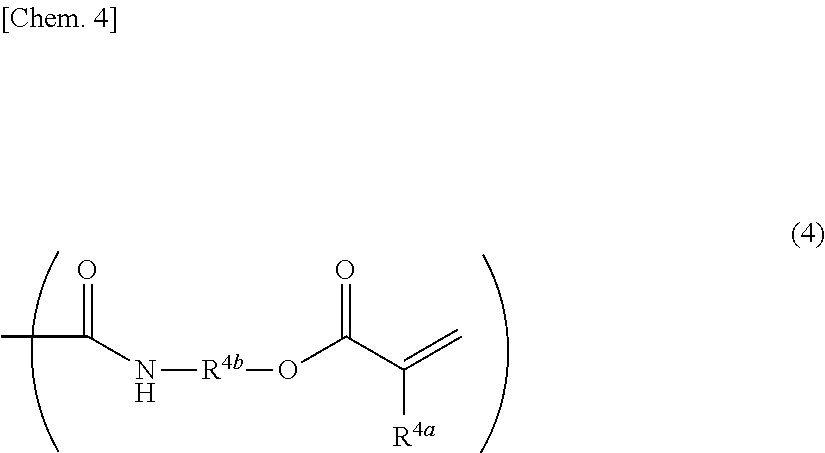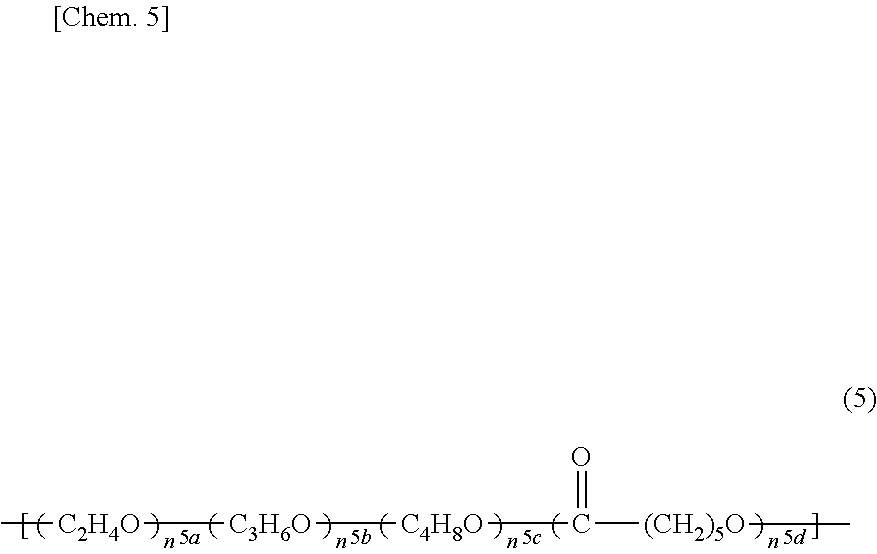Adhesive monomers for dental material
a technology of adhesive monomers and dental materials, applied in the direction of impression caps, group 5/15 element organic compounds, organic chemistry, etc., can solve the problems of insufficient adhesive strength, inability to enhance strength, and inability to develop sufficient adhesive strength, etc., to achieve the effect of enhancing adhesive strength
- Summary
- Abstract
- Description
- Claims
- Application Information
AI Technical Summary
Benefits of technology
Problems solved by technology
Method used
Image
Examples
production example 1
[0183]A 500-milliliter four-necked flask equipped with a stirring blade, a thermometer and a reflux tube was loaded with 100 g (1.09 mol, the number of moles of OH groups: 3.27 mol) of glycerin (manufactured by Sigma-Aldrich Co. LLC), 0.43 g (1000 ppm based on the total weight of reactants) of dibutyltin dilaurate (manufactured by Wako Pure Chemical Industries, Ltd.) and 0.22 g (500 ppm based on the total weight of reactants) of 2,6-t-butyl-4-methylphenol (manufactured by Wako Pure Chemical Industries, Ltd.), and heated to 55° C. Subsequently, 337 g (2.17 mol, 2 / 3 equivalents based on the number of moles of OH of glycerin used) of 2-methacryloyloxyethyl isocyanate (KARENZ MOI (registered trademark), manufactured by Showa Denko K.K.) was added dropwise over a period of 30 minutes. Reaction was carried out for 4 hours at a temperature of 80 to 85° C. The infrared absorption spectrum IR was measured (Spectrum Two, manufactured by PerkinElmer), and the result showed that the isocyanate-...
production example 2
[0185]Except that diglycerin (manufactured by NACALAI TESQUE, INC.) was used in place of the glycerin described in Production Example 1, the same synthesis operation as in Production Example 1 was carried out to give a product containing a compound 3 of the structural formula of the compound 3 below, and a phosphoric acid ester-containing compound 4 of the structural formula of the compound 4 below.
Production 3
[0186]Except that KARENZ MOI-EG (registered trademark) (manufactured by Showa Denko K.K.) containing oxyethylene units in the molecule was used in place of the 2-methacryloyloxyethyl isocyanate (KARENZ MOI (registered trademark)) described in Production Example 1, the same synthesis operation as in Production Example 1 was carried out to give a product containing a compound 5 of the structural formula of the compound 5 below, and a phosphoric acid ester-containing compound 6 of the structural formula of the compound 6 below.
production example 4
[0187]A 300-milliliter four-necked flask equipped with a stirring blade, a thermometer and a reflux tube was loaded with 99.0 g of a polyol 1 (OH group: 1.63 mol) of the structural formula in Table 1 below (ACTCOL (registered trademark), manufactured by Mitsui Chemicals, Inc., average molecular weight: 182, hydroxyl group value: 926 mg KOH / g), 0.27 g (1000 ppm based on the total weight of reactants) of dibutyltin dilaurate and 0.14 g (500 ppm based on the total weight of reactants) of 2,6-t-butyl-4-methylphenol, and heated to 55° C. Subsequently, 171 g (1.10 mol, 2 / 3 equivalents based on the number of moles of OH of the polyol 1 used) of KARENZ MOI was added dropwise over a period of 20 minutes. Reaction was carried out for 8 hours at a reaction temperature of 80 to 85° C. IR measurement was performed, and the result showed that the isocyanate-derived vibration at 2267 cm−1 disappeared. A part of the product was taken, the hydroxyl group value thereof was measured in accordance with...
PUM
| Property | Measurement | Unit |
|---|---|---|
| Mass | aaaaa | aaaaa |
| Pressure | aaaaa | aaaaa |
| Pressure | aaaaa | aaaaa |
Abstract
Description
Claims
Application Information
 Login to View More
Login to View More - R&D
- Intellectual Property
- Life Sciences
- Materials
- Tech Scout
- Unparalleled Data Quality
- Higher Quality Content
- 60% Fewer Hallucinations
Browse by: Latest US Patents, China's latest patents, Technical Efficacy Thesaurus, Application Domain, Technology Topic, Popular Technical Reports.
© 2025 PatSnap. All rights reserved.Legal|Privacy policy|Modern Slavery Act Transparency Statement|Sitemap|About US| Contact US: help@patsnap.com



